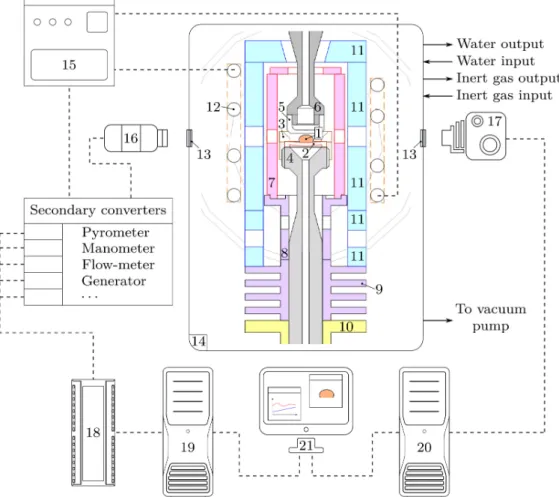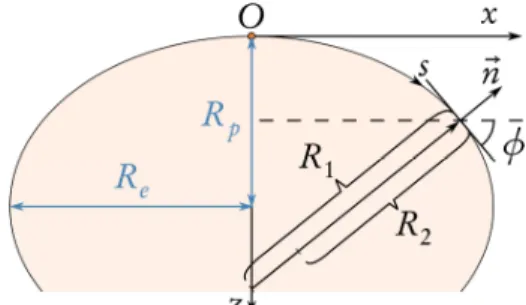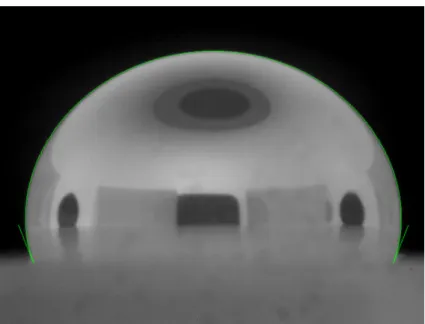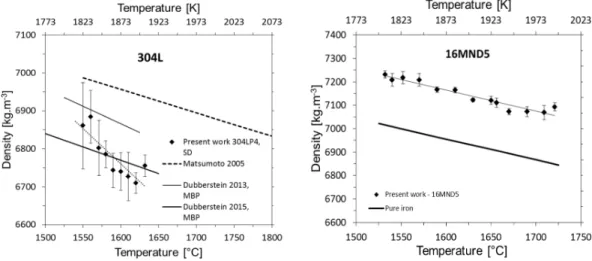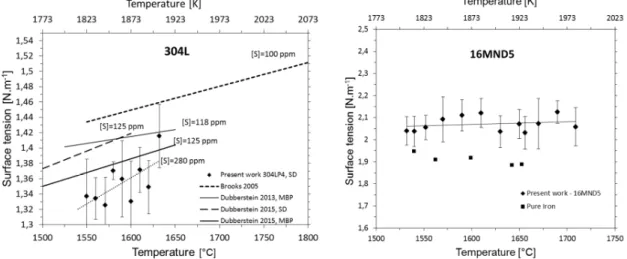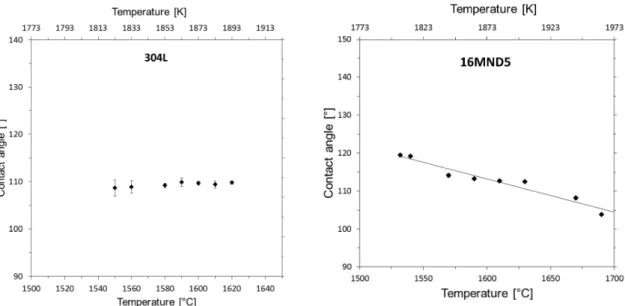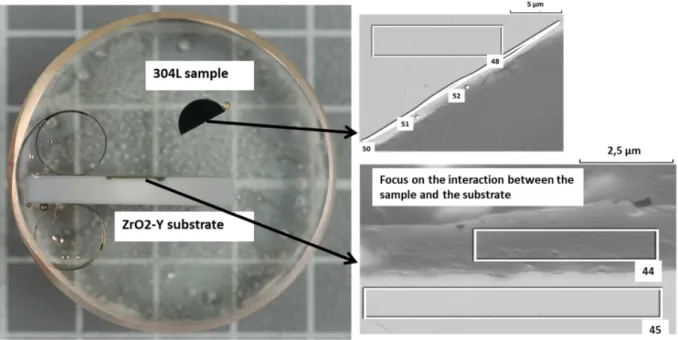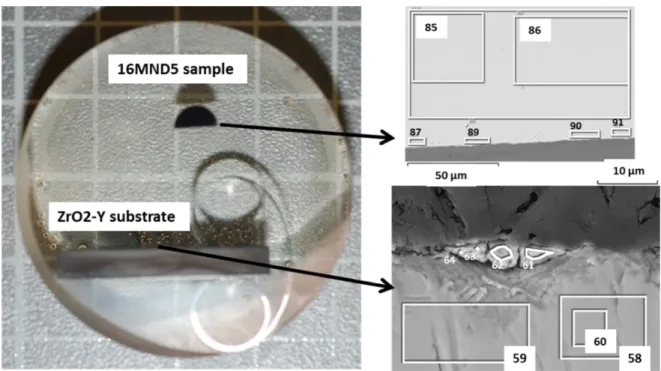HAL Id: hal-02433859
https://hal.archives-ouvertes.fr/hal-02433859
Submitted on 9 Jan 2020HAL is a multi-disciplinary open access archive for the deposit and dissemination of sci-entific research documents, whether they are pub-lished or not. The documents may come from teaching and research institutions in France or abroad, or from public or private research centers.
L’archive ouverte pluridisciplinaire HAL, est destinée au dépôt et à la diffusion de documents scientifiques de niveau recherche, publiés ou non, émanant des établissements d’enseignement et de recherche français ou étrangers, des laboratoires publics ou privés.
influence of steel properties on the progression of a
severe accident measurement of 304l and 16mnd5 steel
density and surface tension
N. Chikhi, P. Fouquart, J. Delacroix, P. Piluso
To cite this version:
N. Chikhi, P. Fouquart, J. Delacroix, P. Piluso. influence of steel properties on the progression of a severe accident measurement of 304l and 16mnd5 steel density and surface tension. The 17th International Topical Meeting on Nuclear Reactor Thermal Hydraulics (NURETH-17), Sep 2017, Xi’An, China. �hal-02433859�
INFLUENCE OF STEEL PROPERTIES ON THE PROGRESSION OF A
SEVERE ACCIDENT: MEASUREMENT OF 304L AND 16MND5 STEEL
DENSITY AND SURFACE TENSION
N. Chikhi∗∗∗∗, P. Fouquart, J. Delacroix and P. PilusoFrench Atomic Energy Commission (CEA), Severe Accident Modeling and Physic Laboratory, 13115 Saint-Paul-lez-Durance, FRANCE
ABSTRACT
The In-Vessel Retention is an attractive strategy to mitigate a severe accident. Nevertheless, due to low margins, it remains questionable for reactors of power 1000MWe and higher. The success of the IVR strategy mainly depends on the inner thermal load, i.e. the heat flux transferred by the molten pool to the vessel, which has to remain lower than the Critical Heat Flux. In some configuration, the stratification of the molten pool may lead to the heat flux concentration in the thermal conductive metallic layer. The understanding of the metal layer behavior is fundamental in order to estimate the inner thermal load. It requires the liquid metal physical properties, such as density and surface tension. In the present paper, original data of the vessel thermophysical properties are proposed for the first time. Measurements of 304L and 16MND5 steel density and surface tension have been made using the sessile drop method. Samples have been melt to form a drop on an yttria-stabilized zirconia substrate and heated up to 200°C above the melting point. The Low Bond Axisymmetric Drop Shape Analysis has been used to estimate the sample density and surface tension and to propose correlations for the density and surface tension as a function of the temperature. The influence of steel properties on the metal layer cooling has been discussed. Especially, the sign of metal temperature surface tension coefficient was found to be most likely positive. In this case, the Bénard-Marangoni flow is opposite to the Rayleigh-Bénard convection flow, limiting the global cooling.
KEYWORDS Severe accident, in-vessel retention, focusing effect, steel and stainless steel properties, surface tension
1. INTRODUCTION
During a severe accident in a nuclear reactor, the core heat up may lead to the formation of a molten pool maintained in the lower plenum. One possible way to preserve the vessel from failure is the external cooling by natural or forced water convection. A part of the success of the In-Vessel Retention (IVR) strategy mainly depends on the inner thermal load, i.e. the heat flux transferred by the molten pool to the vessel, which has to remain lower than the Critical Heat Flux at all points around the lower head. Recently, a large review on the IVR has been done and can be found in [1]: depending on the reactor characteristics, the Critical Heat Flux ranges from 1.5MW/m² to 2MW/m² while the inner thermal load ranges from 0.15MW/m² to 1.7MW/m² [1,5].
According to the progression of the severe accident, some in-vessel configuration can lead to the so-called “focusing effect” (concentration of the heat flux in a thermal conductive metallic layer) and lead to the vessel failure due to high heat flux which will be greater than the CHF. This stratification phenomenon
has been observed previously in MASCA [2] and RASPLAV [3] experiments performed in the framework of OECD project. For reactors of power below 600MWe, the safety margins are sufficient. Thus, several “VVER-440” plants in Europe take advantage of this IVR mitigation strategy, and furthermore, it has led to the design of AP600 reactor [4]. For reactors of power 1000MWe and higher, the assessment of the IVMR strategy remains under investigation because the margins are low [5].
The understanding of the metal layer behavior is fundamental in order to estimate the inner thermal load by “focusing effect”. The thermalhydraulic is mainly driven by Rayleigh-Bénard convection and Marangoni flow at the upper surface [6]. Several experiments have been carried out to study the behavior of a molten pool [7,8,9,10] but few of them have concerned the thin metal layer [11]. To fill this lack and to help modelling/computation of these flows, there is a need for new and reliable data on the liquid metal thermophysical properties such as density, surface tension and viscosity.
In the French nuclear power plant, the vessel is made of 304L austenitic stainless steel and 16MND5 (A508) ferritic steel, while the internal structure of the core are made of 316L and 304L austenitic stainless steel. Most of available data about the vessel steels are focused on their mechanical behavior with a primary objective to assess the thermal shock resistance of the core component [23]. The thermophysical properties at the liquid state (i.e. above the melting point) are scarce for austenitic steels [21,22] and missing for the 16MND5 steel.
In the present paper, the main physical phenomena involved in the IVR are presented (section 2), especially when the focusing effect occurs. Moreover, the effect of the Steel Thermophysical Properties (STP) on the focusing effect is investigated and a short review of the STP existing data in the liquid state is provided.
Furthermore, original thermophysical properties of the 304L and 16MND5 steel, at and above the melting point, are proposed for the first time. Density and surface tension measurements have been performed using the sessile drop method, at CEA-Cadarache on the PLINIUS platform in the VITI facility. The VITI facility and its instrumentation are described in the section 3. The 304L and 16MND5 samples have been melted on a ceramic substrate leading to a non-wetting contact between the metallic liquid drop and the substrate. The axisymmetric drop shape analysis (ADSA) [12,13,14] has been used to estimate the sample density and surface tension. The basics of this methodology are described in the section 3.
The measurement of density, surface tension and contact angle are presented in the section 4 and compared to the existing literature in the section 5. Post-test chemical analyses of the sample and of the substrate have been done to assess their possible mutual contamination/interaction during the tests. Their results are also discussed in the section 4.
2. INFLUENCE OF STEEL PROPERTIES ON THE IN-VESSEL MELT RETENTION 2.1. The in-vessel melt retention and the focusing effect
The corium pool is a complex thermodynamic system including a miscibility gap between liquid phases: one oxidic (U, Zr,O2) and other metallic phases (light phase: mainly Fe, heavy phase: mainly Zr-U). It
may induce the segregation and, consequently, the stratification of the oxide and metallic phases leading to a two-layer or three-layer molten pool as observed during the MASCA [2] and RASPLAV [3] tests. The presence of a thin metallic layer at the top of the molten pool is a great threat for the vessel integrity. The heat transfer from the molten pool to the vessel may be concentrated in the metallic layer due the high thermal conductivity of steel with respect to the oxide phase. This phenomenon is known as “the focusing effect” (FE, Figure 1- left).
Since 1997, IVR studies have been carried out to determine the in-vessel pool thermal load on the vessel wall using stationary configuration of the stratified pool [15,16,17]. More recently, the consideration of the transient stratification of a corium pool in a vessel lower head [18] and the severe accident scenario codes cross-comparison [19] have demonstrated that conservative modelling hypotheses can lead to FE heat flux values largely exceeding the Critical Heat Flux (CHF) associated with the external cooling by water.
To reduce uncertainties and gain safety margin, the thermalhydraulic behavior of the thin metallic layer at the top of the molten pool has been investigated in a recent paper [20]. It was shown that the Rayleigh-Bénard convection was the dominant flow regime for large thicknesses (>0.05m). Between 0.03m and 0.05m, the Rayleigh-Bénard and Bénard-Marangoni effects are of the same order. For small thicknesses (<0.03m), the Bénard-Marangoni effect takes place and may govern the convection flow regime. The Bénard-Marangoni effects could reinforce or decrease the Rayleigh-Bénard convection: if surface tension decreases with temperature increase, the Bénard-Marangoni effects could enhance the heat transfer on the top surface and may consequently diminish the lateral heat flux on the vessel (Figure 1- right).
Figure 1 – The focusing effect during IVR (left) - Bénard-Marangoni current at the surface of the thin metal layer depending on the surface tension variation with temperature (right)
2.3. Density and surface tension of metallic alloys
A short review has been done to collect the existing data on the thermophysical properties of metallic alloys which are used in the core vessel. For material in the liquid state, the available data are scarce. The Figure 2 underlines the important influence of the sulfur content on the evolution of the surface tension of molten steel. Two points have to be stressed (see Figure 2):
1. the surface tension decreases with increase of the sulfur content;
2. the temperature surface tension coefficient sign is mentionned as being dependent to a sulfur content threshold : negative below 50 ppm, positive above 50 ppm.
The Figure 8 and Figure 9 show experimental measurement of density and surface tension from the literature [21,22]. The influence of Oxygen partial pressure was studied in a recent paper [30]. It was
shown that even for low Sulfur content steel, the presence of Oxygen leads to positive the temperature surface tension coefficient
.
Figure 2 – Surface tension as a function of temperature for 316 austenitic steels containing 10 and 50 ppm S (from [25])
3. THE VITI FACILITY AND THE SESSILE DROP METHOD 3.1. Experimental set-up and procedure
The layout of the VITI facility is shown in the Figure 3 and the Figure 4. The sessile drop (1) of liquid steel rests on the lower plane substrate (2), made of yttria-stabilized zirconia. The drop-substrate system is screwed onto the lower substrate holder (4), made of dense graphite, by means of the screwing system (3) in yttria-stabilized zirconia. The upper “substrate” surface (5), screwed onto the upper substrate holder (6), allows for a better heat confinement of the liquid sample in the high-temperature chamber of VITI (VITI HTC), if necessary.
The whole system is heated by so-called “indirect” induction method: the water-cooled inductor (12), connected to the power generator (15) at working frequency f=180 kHz, is electromagnetically coupled with a susceptor (7), made of dense graphite. This susceptor, held by the susceptor holder (8) in dense graphite as well, heats the sample up to the target temperature by radiative heat transfer. The fiber graphite shield (11) is placed around the susceptor, in order to decrease thermal losses and to ensure isothermal conditions for the sessile droplet. The whole assembly lays upon dense graphite fins (9) for heat dissipation, and finally on the global support (10), made of stainless steel. The experiments are carried out within the water-cooled confinement vessel (14), in an inert atmosphere of Argon with absolute pressure 1.3-1.5 bar (after several vacuum pumping/Argon sweeping cycles). A bi-chromatic (λ =0.95 µm, λ = 1.05 µm) video pyrometer (16) is focused on the equator of the drop, as well as the high-definition and high-speed camera (17), through adequate windows (13) and holes provided in the HTC design. Finally, the whole acquisition data is collected by the data bus (18) and sent to the data acquisition computer (19), while the imaging computer (20) allows for sample monitoring. The final stage consists of the full post-treatment analysis in an integrated tool (21).
Figure 3 - Scheme of the VITI facility. 1: drop; 2: lower substrate; 3: screwing system; 4: lower substrate holder; 5: upper (confinement) substrate; 6: upper substrate holder; 7: susceptor; 8: susceptor holder; 9: fins; 10: global support; 11: thermal shield; 12: inductor; 13: window; 14: Viti confinement vessel; 15: generator; 16: pyrometer; 17: camera; 18: data bus; 19: data acquisition computer; 20: imaging computer; 21: post-treatment analysis.
3.2. Experimental issues
The accuracy of our experimental measurements is directly linked to the design of our characterization test-bench. In this section, let us highlight the most insightful issues in this respect, i.e. selection and preparation of the substrate-sample system, the influence of indirect induction heating and temperature measurements.
3.2.1. Selection and preparation of the substrate-sample system
A typical substrate-sample system is depicted in Figure 4. The original (i.e. before melting) samples consist of either 304L or 16MND5 cylindrical pellets. Two sizes of pellets are tested, the “small” one corresponding to pellets characterized by diameter×height = 6mm×3mm, and the “large” one corresponding to pellets characterized by diameter×height = 8mm×4mm. Once the melting point reached, the pellets become ellipsoidal droplets, whose equatorial and polar diameters are roughly equivalent to the original diameter and height. A plane (machine precision) substrate of diameter 25mm made of yttria-stabilized zirconia is selected, because of its reliable chemical compatibility with liquid metals (see e.g. [16]). Both the sample and the substrate are weighed (with 10-4 g accuracy) before and after the test, to check the hypothetical mass losses (evaporation, interaction).
A particular care has been taken concerning the preparation and storage of steel samples. In order to remove the chromium oxide at the surface of the sample, the pellets are first exposed to chemical pickling in a 20% HNO3 – 2.5% HF aqueous bath, for 4 hours. Then, they are stored in acetone to prevent further
oxidation. They are transferred into VITI confinement vessel at the very beginning of the experimental campaign.
3.2.2. Influence of indirect induction heating
The major interest of indirect induction heating lies in the significant decrease of the side-effects of magnetic induction, both on the shape and on the stability of the droplet under consideration, thanks to the susceptor acting similarly to a Faraday cage around the sample.
Let us first remind that the penetration depth of the AC (pulsation: = 2 ) electromagnetic field inside a given non-ferromagnetic material of (vacuum) magnetic permeability and electrical conductivity is defined as such:
= (1)
The susceptor of thickness e shall act as an efficient Faraday cage only if e≥5δ [26] induction heating. In our case, σ∼10⁶ S/m, and f=180 kHz, which leads to δ∼1mm according to Eq. (1), while e=6mm. Consequently, the electromagnetic shielding provided by the susceptor is theoretically sufficient to avoid the penetration of potentially interfering electromagnetic fields in VITI HTC.
3.2.3. Temperature measurements and homogeneity
Temperature measurements are performed with a bi-chromatic video pyrometer working at two wavelengths = 0.95 µm and = 1.05 µm, and focused on the equator of the liquid droplet. The size of the latter is typically the same as the size of the focusing spot, which makes the checking of temperature homogeneity at the surface of the droplet quite tricky. Nevertheless, heat confinement has been optimized, so that the main source of temperature heterogeneity is due to the presence of small holes in both the susceptor and the thermal shield in order to record images and to measure temperature with the bi-chromatic pyrometer. The heterogeneity has been estimated to a maximum of 10°C difference at
1800°C (apex temperature-uncertainty ~0.5%) between the apex and the equator of the droplet, due to the high thermal conductivity of steel, which tends to smooth temperature gradients at drop scale [27]. This estimation, added to the pyrometer manufacturer uncertainty (2%), leads to the (conservative) estimation of 2.5% uncertainty about our temperature measurements.
3.3. Surface tension and density measurements by axisymmetric drop shape analysis (ADSA)
Figure 5: Typical geometry for axisymmetric drop shape analysis.
The fundamentals of ADSA technique, originally proposed in [12], have been extensively used in numerous works (see [28] for a review). Assuming that the droplet has a vertical axis of symmetry passing through the apex and that it is a quiescent droplet resting on the substrate (so that surface tension and gravity are the only forces shaping the drop), the Young-Laplace equation can be written:
! = " #
$ %& (2)
where , (, , !, ( , ( and stand for surface tension, apex curvature radius, density, axial coordinate (taken from the apex in the direction of gravity, see Figure 5), the two principal curvature radii at a given point of the liquid surface, and gravity constant, respectively. The Equation. 2 is the well-known insoluble second-order differential equation of Young-Laplace.
To solve this problem, one approach consists in applying the perturbation theory to Eq.2 to obtain a simpler analytical solution. As described in [13,14], the so-called Low-Bond Axisymmetric Drop-Shape Analysis (LBADSA) allows for the determination of a closed-form solution, valid for asymptotically small values of the Bond number, the latter being defined by:
)*=+,
%
(3)
The Bond number expresses the competition between gravity and surface tension forces. When it is low, the droplet deviates only slightly from a spherical shape, while oblate droplets are characterized by large Bond numbers. LBADSA remains typically valid for Bond values up to unity. For the sake of cross-comparison, LBADSA is also applied to the suitable droplet profiles.
In the present work, the LBADSA techniques have been used to fit the drop shape edge and estimate the density and surface tension of the samples (see Figure 6 and Figure 7).
Figure 6 – Image of a sessile drop of molten 304L steel on yttria-stabilized zirconia substrates at 1590°C, with the Young-Laplace interpolation line (green).
Figure 7 – Image of a sessile drop of molten 16MND5 steel on yttria-stabilized zirconia substrates at 1550°C, with the Young-Laplace interpolation line (green).
4. EXPERIMENTAL RESULTS
Two samples made of 304L and 16MND5 have been studied. The samples have been melt to form a drop and heated up to 200°C above the melting point in the VITI facility using the sessile drop technique. Experimentally, the 304L stainless steel sample has been found to melt at 1450°C and 16MND5 steel melts at 1520°C. The estimation of density and surface tension has been done for several temperature. For a given temperature, ten drop images (corresponding to ten different instants) have been analyzed using
LBADSA: the average value and the standard deviation are represented both for density and surface tension measurements.
4.1. Density measurement
The Figure 8 (left) shows the evolution of the liquid 304L stainless steel density of as function of temperature measured by the sessile drop technique. Some data coming from the open literature have been added to compare this work and previous studies.
The density decreases from 6880 to 6710 - ../3, when the temperature increases from 1550°C to 1630°C. The density can be related to the temperature by the following correlation:
1 23,456 = 7.040 9 101/ 1,866 9 => / 1450 (4)
The results are in good agreement with the results obtained with various techniques from other experimental facilities (Figure 8).
The measurements of the liquid 16MND5 steel density as function of temperature are drawn in the Figure 8 (right). The density decreases from 7230 to 7070 - ../3, when the temperature increases from
1530°C to 1720°C. The density can be related to the temperature by the following correlation:
?@ABC,456 7.236 9 101/ 0.89 9 => / 1520 (5)
The data about the 16MND5 steel are new and original. As the composition of 16MND5 is closed to pure iron (see Table 2), the data about pure iron from [25] have been plotted in the Figure 8 (right).
Figure 8 - Density of molten 304L stainless steel (left) and of molten 16MND5 ferritic steel (right) measured on yttria-stabilized zirconia substrates(Sessile Drop: SD, Maximum Bubble Pressure: MBP).
4.2. Surface tension measurement
The Figure 9 (left) shows the measurements of surface tension of liquid 304L stainless steel as function of the temperature measured by the sessile drop technique. The surface tension increases from 1.325 to 1.415 (N/m), when the temperature increases from 1550°C to 1620°C. The surface tension (N/m) can be expressed as a function of the temperature (°C):
1 23,456 1.275 / 7 9 => / 1450 9 10D2 (6)
As for the density, the results of surface tension measurement are in good agreement with the results obtained with various techniques from other facilities (Figure 8). According to the Sulfur content ([S] = 280ppm), it was expected to have a positive temperature surface tension coefficient . Moreover, the surface tension of our sample is lower than the surface tension of samples with lower Sulfure content. The measurements of the liquid 16MND5 steel surface tension as a function of temperature are drawn on the Figure 9 (right). The surface tension was nearly constant when the temperature increases from 1530°C to 1720°C. The surface tension (N/m) can be related to the temperature (°C) by the following correlation:
?@ABC,456= 2.06 / 1.12 9 => / 1520 9 10D2 (7)
The data about the 16MND5 steel, which are new and original, have been plotted in the Figure 9 (right).
Figure 9 - Surface tension of molten 304L stainless steel (left) and molten 16MND5 ferritic steel (right) measured on yttria-stabilized zirconia substrates(Sessile Drop SD, Maximum Bubble Pressure MBP)
4.3. Contact angle
The Figure 10 illustrates the changes of contact angle with time between the substrate and the molten drop. During the test with the 304L sample, the contact angle remains quite constant and was equal to 110°. In a different way, the contact angle decreases from 120° to 105° when the 16MND5 molten drop was heated on the substrate.
Figure 10 – Variation of contact angle of molten 304L stainless steel (left) and of 16MND5 ferritic steel (right) measured on yttria-stabilized zirconia substrates
4.4. Sample post-test chemical analyses
Whatever the heat treatment at high temperature above the liquidus temperature close to atmospheric pressure of a multi-element mixture like steel or stainless steel, there are always the possibility of evaporation of some elements and, using sessile drop method, interaction and possibly dissolution of the substrate, meaning heterogeneity or modification of the composition of the droplet. For these reasons, Post-Test Analyses (PTA) have been done on the steel and stainless steel samples after thermophysical properties measurements in VITI facility.
First, it has been seen that the mass of sample remains constant during the tests. Second, Scanning Electron Microscopy (SEM) coupled with Energy Dispersive Spectroscopy (EDS) analyses have been performed on both samples. For SEM examinations, the metallographic samples were molded with resin and polished with an automatic polishing machine by using lubricant and polishing (diamond) solutions. The samples are examined with a ZEISS EVO HD15MA SEM (LaB6 filament) equipped with an
OXFORD SDD XMax 50 EDS detector for chemical analysis. The SDD X-Max 50 has an energy resolution of 124 eV on MnKα line. The micrographs presented are made with BackScattered Electrons (BSE). The grey levels mainly indicate composition differences: the higher is the density in heavier elements. The samples after metallographic preparation are shown in Figure 11 and Figure 12.
4.1.1. Migration of steel elements towards yttria stabilized zirconia
For the 304L stainless steel sample, it appears that a few amount of iron and a more important of silicon have migrated into the yttria stabilized zirconia (see Table1) whereas no migration of element coming from the 16 MND5 to the yttria stabilized zirconia has been observed (see Table 2). These results show a limited interaction between the two steel families and the yttria stabilized zirconia. The specific migration of silicon for stainless steel has been previously observed [29] and should modify the thermophysical properties of the stainless steel.
Figure 11 - Backscattered electron images of cross-section for the 304L/ZrO2–Y2O3 system cooled from 1630°C
Table 1 – Chemical compositions of 304L/ZrO2-Y2O3 reactive interface obtained by quantitative analyses (weight %) Analysis n° Zr O Fe Si Cr Mn Mo Ni 48 (Sample) 1.1 68.5 0.58 18.28 1.04 2.19 8.32 50 (Interface) 2.12 68.74 1.01 18.21 1.14 8.26 51 (Interface) 4.40 66.93 2.42 17.27 0.77 8.14 52 (Interface) 7.46 3.48 0.44 16.63 0.89 7.28 45 (Substrate) 77.67 22.33 44 (Interface) 48.02 35.16 0.73 14.17
4.1.2. Migration of yttria stabilized zirconia elements towards steel
For both 16 MND5 steel and 304L stainless samples, no pollution in zirconium is observed (see Tables 1 and 2). For the oxygen, it can be noted that some oxygen is detected at the surface of the 304L stainless sample whereas no oxygen is detected for the 16 MND5. This could be attributed to the formation of a thin protective chromite layer for the 304L stainless which does not exist for the 16 MND5 steel.
As a preliminary conclusion, it can be stated that small modification in elemental composition has occurred during the heat treatment in VITI-C but with limited impact on thermophysical properties.
Figure 12 - Backscattered electron images of cross-section for the 16MND5/ZrO2–Y2O3 system cooled from 1690°C
Table 2 – Chemical compositions of 16MND5/ZrO2-Y2O3 reactive interface obtained by quantitative analyses (weight %)
Analysis n° Zr O Fe Si Cr Mn Mo Ni 85 (Sample) 96.88 0.27 0.22 0.97 0.87 0.78 86 (Sample) 96.87 0.31 0.17 1.05 0.85 0.75 87 (Interface) 97.97 0.22 1.04 0.77 90 (Interface) 97.81 0.33 0.22 1.02 0.61 58 (Substrate) 74.47 25.53 59 (Substrate) 73.39 26.61 60 (Substrate) 74.90 25.10 61 (Interface) 68.99 31.01 62 (Interface) 70.00 30.00 63 (Interface) 76.01 23.99 64 (Interface) 72.31 27.69
5. DISCUSSION OF THE RESULTS AND PERSPECTIVES 5.1. Experimental methodology
After the experiments, it was found that the solidified droplet does not hold tightly on the yttria-stabilized zirconia substrates both for 304L and 16MND5 samples, showing absence of strong interaction. The micrographic observation made on the cross section perpendicular to the interface of samples shows that
for the 304L sample there is one layer between the molten drop and the ZrO2 as illustrated in the Figure 11 and the Table 1. Although a reaction occurs at interface of 304L/ZrO2–Y2O3, the contact angle remains
relatively stable and larger than 90°. For the 16MND5 sample, the interaction between the molten drop and the solid substrate remains very limited such that no element exchange could have been observed with micrographic observation (Figure 12 and Table 2).
To go further, it would be interesting to implement a measure of the partial oxygen pressure and to make post-test chemical analyses at the external surface of the droplet. Moreover, in the framework of the IVR strategy assessment, it would be necessary to carry out tests on mixture of the 304L and 16MND5 steels. 5.2. Impact of the Bénard-Marangoni effect on the metal layer cooling
As explained in the section 2.1, the Bénard-Marangoni current at the free surface atop the thin metal layer may enhance or slow down the Rayleigh-Bénard convection flow depending on the temperature surface tension coefficient sign. The experimental results presented in the previous section show that the case
>0 is the most likely. Actually, only pure elements provide negative coefficient and the case of mixture remains an open question.
Assuming that > 0, the Bénard-Marangoni flow current would be in countercurrent to the Rayleigh-Bénard flow. In this case, 3D flow calculation is required to evaluate the resulting flow. For this reason, CFD activities have been initiated recently in the framework of IVR strategy assessment by EDF and CEA [24]. Encouraging results have been obtained for code assessment on BALI [11] water-based tests. The development of a new thermophysical data base, as presented in this paper, will be necessary to extrapolate to the corium molten pool in the reactor case.
6. CONCLUSIONS
Measurements of 304L and 16MND5 steel density and surface tension have been performed using the sessile drop method on VITI facility (CEA-Cadarache/PLINIUS Severe Accident Platform). Pellet-like samples have been melt to form a drop on a substrate made of yttria-stabilized zirconia and heated up to 200°C above the melting point. The LBADSA technique has been used in order to fit the drop edge with the Laplace-Young equation and also estimate the sample density and surface tension.
The measurement of 304L liquid steel surface tension and density were found to be in good agreement with the existing literature showing the good reliability of VITI experiments. The measurements of liquid 16MND5 steel thermophysical properties are new and original.
The influence of steel properties on the progression of a severe accident has been discussed to help the assessment of the in-vessel retention strategy. The penalizing case of the stratification of the molten pool has been considered. It was shown that the steel properties such as density and surface tension play an important role in the thermalhydraulic of the thin metallic layer. Especially, the sign of liquid metal temperature surface tension coefficient was found to be most likely positive. It leads to countercurrent Bénard-Marangoni and Rayleigh-Bénard flows, limiting the global molten pool cooling.
To go further, investigations of the thermophysical properties of both 304L/16MND5 mixture and light/heavy metal mixture have been proposed in the frame of European IVMR and SAFEST projects in order to evaluate the exact impact on “focusing effect”.
ACKNOWLEDGMENTS
This work has been partially funded by the Horizon 2020 “IVMR” project of the European Commission. Post-test chemical analyses were performed at the CEA/LIPC lab by Patricia Correggio (CEA/LPMA) and Brigitte Tormos (CEA/LIPC): the authors are very grateful to them for their support. At last but not least, the authors would like to thanks L. Saas, R. Le Tellier and B. Turquais (CEA/LPMA) for fruitful discussions on the thermalhydraulic of a thin metal layer during IVR.
REFERENCES
1. W. Ma, Y. Yuan, B. R. Sehgal, In-Vessel Melt Retention of Pressurized Water Reactors: Historical Review and Future Research Needs, Engineering, Vol 2, 103–111(2016)
2. D. Tsurikov, MASCA2 Project: major activities and results. In: Material Scaling Seminar; 2007 Oct 11–12; Cadarache, France; (2007)
3. V. Asmolov, D. Tsurikov, RASPLAV project: major activities and results. In: Proceedings of
OECD/NEA RASPLAV Seminar; 2000 Nov 14–15; Munich, Germany (2000)
4. B.R. Sehgal, A. Karbojian, A. Giri, O. Kymäläinen, J.M. Bonnet, K. Ikkonen, R. Sairanen, S. Bhandari, M. Buerger, J. Dienstbier, Z. Techy, T. Theofanous, Assessment of reactor vessel integrity (ARVI), Nuclear Engineering and Design, Vol 235, pp213-323 (2005)
5. F. Fichot, J-M. Bonnet, B. Chaumont, IRSN views and perspectives on in-vessel melt retention strategy for severe accident mitigation, Proceeding of EUROSAFE Forum, 2-3 nov 2015, Brussels,
Belgium, (2015)
6. L. Saas, R. Le Tellier, E. Skrzypekb, Rayleigh-B´enard and B´enard-Marangoni convection in a thin metallic layer on top of corium pool, 8th ERMSAR conference, 16-18May, Warsaw, Poland, 2017 7. Kymäläinen O, Tuomisto H, Hongisto O, Theofanous TG. Heat flux distribution from a
volumetrically heated pool with high Rayleigh number. Nuclear Engineering and Design, 149 (1994) 8. Theofanous TG, Maguire M, Angelini S, Salmassi T. The first results from the ACOPO experiment.
Nuclear Engineering and Design,169 (1997)
9. Sehgal BR, Bui VA, Dinh TN, Green JA, Kolb G. SIMECO experiments on in-vessel melt pool formation and heat transfer with and without a metallic layer. In:Proceedings of the Workshop on In-Vessel Core Debris Retention and Coolability; Mar 3–6 1998; Garching, Germany; pp. 198–206. (1998)
10. Gaus-Liu X, Miassoedov A, Cron T, Wenz T. In-vessel melt pool coolibility test—description and results of LIVE experiments. Nuclear Engineering and Design ,240 (2010)
11. J-M. Bonnet, Thermal hydraulic phenomena in corium pools for ex-vessel situations: the BALI experiment. In: Proceedings of the 8th International Conference on Nuclear Engineering; 2000 Apr
2–6; Baltimore, Maryland. New York: American Society of Mechanical Engineers pp 79–86. (2000)
12. Y. Rotenberg, L. Boruvka, A.W. Neumann, Determination of surface tension and contact angle from the shapes of axisymmetric fluid interfaces, Journal of Colloid and Interface Science, Vol 93, pp169-183 (1983)
13. A.F. Stalder, T. Melchior, M. Müller, D. Sage, T. Blu, M. Unser, Low-Bond Axisymmetric Drop Shape Analysis for Surface Tension and Contact Angle Measurements of Sessile Drops, Colloids and
Surfaces A: Physicochemical and Engineering Aspects, vol. 364, no. 1-3, pp. 72-81 (2010)
14. A.F. Stalder, G. Kulik, D. Sage, L. Barbieri, P. Hoffmann, A Snake-Based Approach to Accurate Determination of Both Contact Points and Contact Angles, Colloids And Surfaces A: Physicochemical
And Engineering Aspects, vol. 286, no. 1-3, pp. 92-103 (2006)
15. J.L. Rempe, D.L. Knudson, C.M. Allison, G.L. Thinnes, C.L. Atwood, M.J. Cebull, “Potential For AP600 In-Vessel Retention Through Ex-Vessel Flooding”, Tech. Report INNEL/EXT-97-00779 (1997)
16. H. Esmali, M Khatib-Rahbar, “Analysis Of Likelihood Of Lower Head Failure And Ex-Vessel Fuel Coolant Interaction Energetics For Ap1000”, Nuclear Engineering And Design, Vol. 235 (2005) 17. T.G. Theofanous, C. Liu, S. Addition, S. Angelini, O. Kymalainen, T. Salmassi, In-Vessel Coolability
And Retention Of A Core Melt, Nuclear Engineering And Design, Vol. 169 (1997)
18. R. Le Tellier, L. Saas, S. Bajard, “Transient Stratification Modelling Of A Corium Pool In A LWR Vessel Lower Head”, Nuclear Engineering And Design, Vol. 287 (2015)
19. M. Sangiorgi et al., "In-vessel melt retention (IVMR) analyses of a VVER-1000 NPP," Tech. Report
JRC Petten, The Netherlands (2015)
20. L. Saas, R. Le Tellier, E. Skrzypek, Rayleigh-Bénard and Bénard-Marangoni convection in a thin metallic layer on top of corium pool , Proceeding of ERMSAR-2017, Warsaw, Poland, 16-18 May 2017
21. T. Dubberstein, H-P. Heller, J. Klostermann, R. Schwarze, J. Brillo, Surface tension and density data for Fe–Cr–Mo, Fe–Cr–Ni and Fe–Cr–Mn–Ni steels, Journal Material Sciences, Vol 50, pp7227–7237 (2015)
22. R. F. Brooks, P. N. Quested, The surface tension of steels, Journal of materials sciences, Vol. 40, pp2233 – 2238 (2005)
23. S. Sekfali, Influence de la microstructure sur le comportement local dans les aciers 16MND5, PhD,
Ecole Centrale Paris, HAL Id:tel-00419622 (2004)
24. C. Le Guennic, L. Saas, R. Le Tellier, Y. Wu, M. Guingo, J. Laviéville, Contribution of CFD studies to IVR assessment, Proceeding of ERMSAR-2017, Warsaw, Poland, 16-18 May (2017)
25. K.C Mills, R.F. Brooks, Measurement pf thermophysical properties in high temperature melts,
Materials Science and Engineering, Vol A178, pp 77-81 (1994)
26. Lucia, O., Maussion, P., Dede, E.J., Burdio, J.M.: Induction Heating Technology and Its Applications: Past Developments, Current Technology, and Future Challenges. In: IEEE Trans. Ind. Electron., vol. 61, pp. 2509–2520, 2014.
27. Barbé, J.C.: Sustentation sur film de gaz : application à l’étude de la rhéologie des mélanges de type corium-béton. Thesis : INPG, France, (2000).
28. M. Hoorfar, A.W. Neumann “Recent progress in Axisymmetric Drop Shape Analysis” Advances in
Colloid and Interface Science 121 (2006) 25-49
29. M. Sanchez-Brusset, Mécanismes d’oxydation de l’acier liquide lors de l’Interaction Corium-Béton à haute température en cas d’accident grave de réacteur nucléaire, Ph-D Thesis, UNIVERSITE DE
PERPIGNAN VIA DOMITIA (2015).
30. S. Ozawa, K. Morohoshi, T. Hibiya, Influence of Oxygen Partial Pressure on Surface Tension of Molten Type 304 and 316 Stainless Steels Measured by Oscillating Droplet Method Using Electromagnetic Levitation, ISIJ Internation, Vol 54, N°9, pp 2097-2103 (2014)
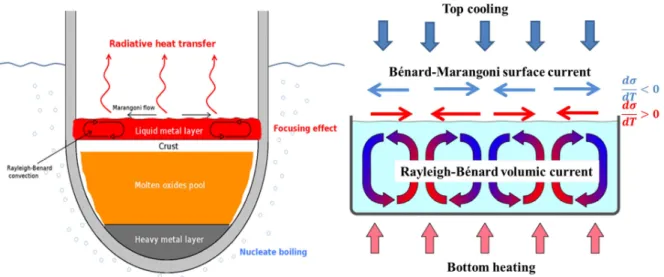
![Figure 2 – Surface tension as a function of temperature for 316 austenitic steels containing 10 and 50 ppm S (from [25])](https://thumb-eu.123doks.com/thumbv2/123doknet/12994173.379580/5.892.104.728.155.515/figure-surface-tension-function-temperature-austenitic-steels-containing.webp)
